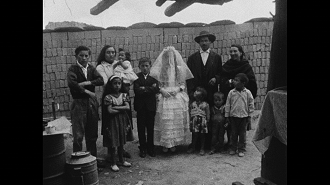
Chircales 1971
Distributed by Third World Newsreel, 545 Eighth Avenue, Suite 550, New York, NY 10018; 212-947-9277
Directed by Marta Rodriguez and Jorge Silva
Streaming, 42 mins
College
Labor relations; Poverty; Sociology
Date Entered: 09/11/2020
Reviewed by Sam Buechler, Student Success Librarian, Washington State University VancouverThe remastered documentary Chircales (translated to The Brickmakers) focuses on the impoverished Castañeda family of brickmakers residing in the outskirts of Bogotá, Colombia. We quickly learn through a narrator that brickmaking is part of an inequitable labor agreement that severely disadvantages many within the Colombian capitol. Through this narration, as well as political speeches and testimony, the film provides a strong foundation to build upon as we move through life with the Castañeda family.
The narrator ultimately proves to be the strongest teacher of the film providing explanation to some of the concepts surrounding labor activism and the labor model that the Castañeda family is subject to. Comparatively, the speeches serve well to bring contrast to the visuals we see, but a better job could be done to provide context to the state of the Colombian government and its people. These speeches, in conjunction with the family testimony, emotionally charged visuals, and a haunting sound design, serve to create a strong rhetoric towards empathy and anger to the injustices being displayed.
One of the more striking moments in the family testimony is when we learn early on that one member of the Castañeda family, a mother of twelve, is pregnant with her thirteenth. Upon visiting the doctor and informing on how many children she has, the doctor responds, “Why bring more beggars into the world?” This film essentially takes that question and asks it of the political and social systems that are more directly responsible for the poverty we are witness to instead. As a result, we are left with a film that exposes how poverty, housing insecurity, and unjust labor practices affects some of the most universal life moments (childhood, pregnancy, aging, and death) and the culturally important ones as well (communion and marriage).
Overall, this film takes an emotional approach to exposing the systems that feign ignorance to labor and economic injustices within its borders and does so with a unique and engaging vision. As a piece that is time-bound, however, it is lacking some critical context for the conditions and considerations the directors are asking us to understand. This does not, however, pose an issue if viewed in a course that is positioned to provide that context. Ultimately, this film is engaging and can easily function as a vehicle for discussion and critical thinking exercises and is thus recommended.